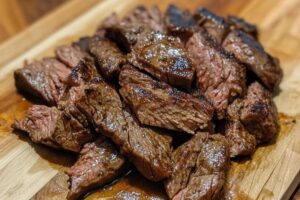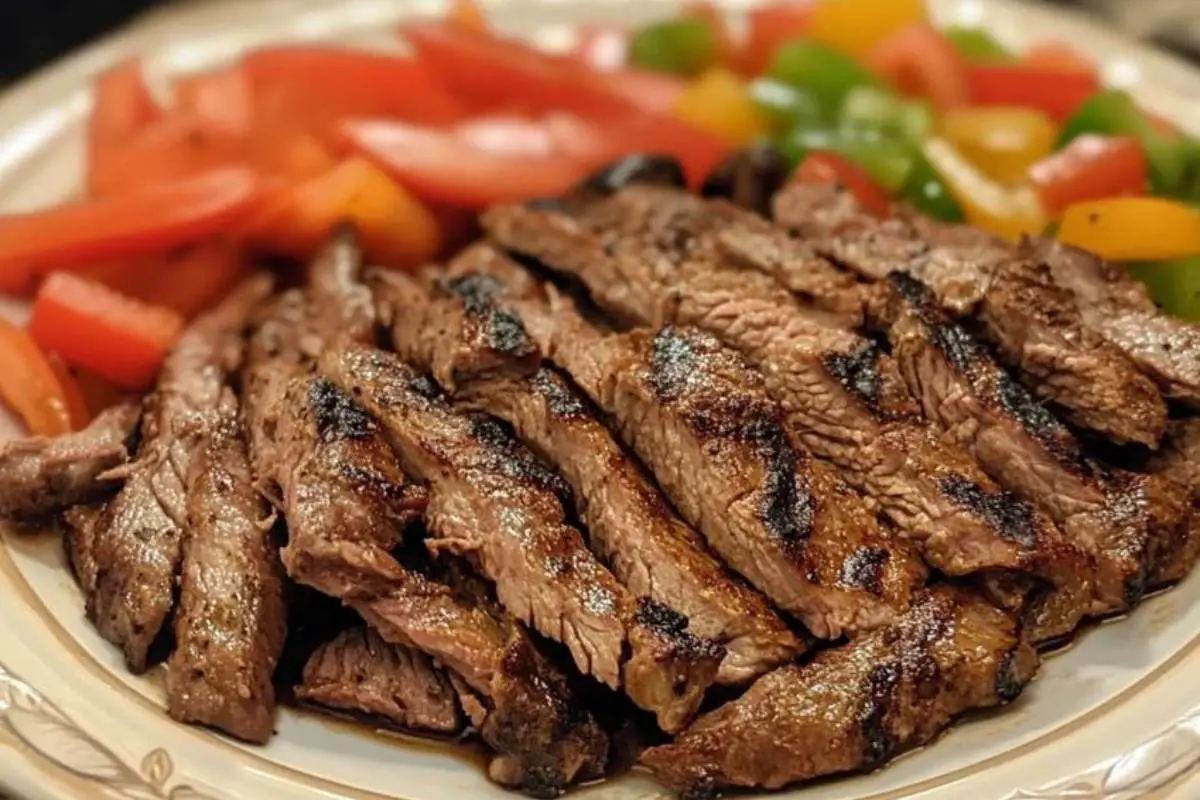Making your fajita meat tender and juicy is key to great Mexican dishes. Whether it’s steak or chicken fajitas, the meat’s tenderness matters a lot. This guide will show you how to make your fajita meat tender and tasty. We’ll cover choosing the right cuts, marinating, and cooking techniques.

Key Takeaways
- Understanding the factors that affect meat tenderness is essential for achieving the perfect fajita texture.
- Selecting the right cut of meat, such as flank steak or skirt steak, can make a significant difference in the final tenderness.
- Marinating the fajita meat in the right combination of ingredients can tenderize and infuse it with flavor.
- Proper cooking methods, such as grilling or searing, can help lock in the meat’s tenderness and juiciness.
- Slicing the fajita meat against the grain is a crucial step for ensuring a tender bite.
The Secret to Tender Fajita Meat
Tender fajita meat is key to a great fajita dish. Knowing what makes meat tender is important for the perfect bite. Let’s look at the main things that make fajita meat tender and how to cook fajitas just right.
Understanding the Importance of Tenderness
Tender fajita meat makes for a better dining experience. If the meat is tough, it can ruin the taste and feel of the fajitas. Tenderness is what makes a dish good and enjoyable to eat.
Factors that Affect Meat Tenderness
Several things affect the tenderness of fajita meat. The meat cut, muscle type, and cooking method all matter. Knowing these can help you choose and cook your fajita ingredients better.
| Factor | Impact on Tenderness |
|---|---|
| Cut of Meat | Certain cuts, like flank steak or skirt steak, are naturally more tender. |
| Muscle Structure | Muscles that are less active and have finer fibers tend to be more tender. |
| Cooking Method | Grilling or marinating can help tenderize the meat and improve its texture. |
By knowing these factors affecting fajita meat tenderness, you can choose and cook your meat to be tender and tasty every time.
“The secret to tender fajita meat lies in the careful consideration of the factors that influence its texture and mouthfeel.”
Selecting the Right Cut of Meat
Choosing the right meat for fajitas is key to a great dish. The best cuts offer a perfect mix of tenderness and flavor. Let’s look at the top picks to boost your fajita game.
For beef fajitas, flank steak and skirt steak are top choices. They have a strong beef taste and are tender when cooked right. Flank steak is especially popular because it’s affordable and marries well with marinades and quick cooking.
For chicken fajitas, go for boneless, skinless chicken thighs. The thighs are juicier and more tender than breasts, making them perfect for fajitas. Chicken tenderloins are also great, as they’re naturally tender and soak up flavors well.
| Cut of Meat | Ideal for Fajitas | Why It Works |
|---|---|---|
| Flank Steak | Yes | Robust beefy flavor, tender when properly prepared |
| Skirt Steak | Yes | Tender and flavorful, responds well to quick cooking |
| Chicken Thighs | Yes | Juicier and more tender than chicken breasts |
| Chicken Tenderloins | Yes | Naturally tender and absorb marinades and seasonings well |
Whether you prefer beef or chicken, the secret is to pick cuts that are naturally tender or can be made tender. With the right meat, your fajitas will be a hit with everyone.
Marinating for Maximum Tenderness
Marinating is key to tenderizing your fajita meat. It adds flavors and enzymes that make tough cuts tender and juicy. Let’s dive into the secrets of a delicious fajita meat marinade.
Choosing the Right Marinade Ingredients
The right ingredients are crucial for a great fajita meat marinade. Acidic things like citrus juices and vinegar break down tough fibers. Seasonings like garlic, cumin, and chili powder add depth and flavor.
Marinating Time and Techniques

- For the best marinating tips for tender fajitas, marinate for 2-4 hours or up to 24 hours for tougher cuts.
- Flip or rotate the meat often to ensure even marinade coverage.
- Use a sealable plastic bag or non-reactive container for better flavor absorption.
By following these how to marinate fajita meat tips, you’ll serve tender, flavorful fajita meat. It’s sure to wow your guests.
“Marinating is the secret to unlocking the true potential of your fajita meat. With the right blend of ingredients and technique, you can transform even the toughest cuts into a tender, flavor-packed delight.”
Tenderizing Techniques for Fajita Meat
There are many ways to make fajita meat tender. We’ll look at both mechanical and chemical methods. Each has its own benefits and drawbacks. This will help you pick the best method for your fajitas.
Mechanical Tenderizing Methods
Mechanical tenderizing uses force to break down meat fibers. Here are a few ways to do it:
- Pounding the meat with a meat mallet or tenderizing tool
- Running the meat through a mechanical tenderizer, which uses blades or needles
- Scoring the meat with a sharp knife for deeper marinade penetration
This method is quick and effective for tough cuts. But, be careful not to overdo it. Too much pounding or scoring can make the meat mushy.
Chemical Tenderizing Agents
Chemical tenderizers break down meat tissue with enzymes. Common ones for how to tenderize fajita meat include:
- Papain, from papayas
- Bromelain, from pineapples
- Acids like vinegar, wine, or citrus juices
When using chemical tenderizers for fajitas, follow the instructions closely. Avoid overexposure to prevent mushiness. Try different mechanical tenderizing for fajitas and chemical agents to find the right mix for your fajitas.
The choice between mechanical and chemical methods depends on your preference, the meat cut, and your time. By exploring these techniques, you can achieve tender fajita meat every time.
How do I get my fajita meat tender?
Getting your fajita meat tender is key to making delicious Mexican dishes. Whether you grill, sauté, or stir-fry, a few tips can help. Let’s uncover the secrets to tender fajita meat every time.
Select the Right Cut of Meat
Start by choosing the right cut. Opt for flank steak, skirt steak, or hanger steak. These cuts are tender and flavorful. Avoid pre-sliced meat to prevent chewiness.
Marinate for Optimal Tenderness
Marinating your meat is crucial for tenderness. Use acidic ingredients like lime juice or vinegar in your marinade. Let it marinate for at least 30 minutes, or up to 8 hours for best results.
Employ Tenderizing Techniques
There are more ways to tenderize your meat. Pounding it with a meat mallet or rolling it can break down fibers. You can also use a meat tenderizer enzyme to soften it.
By choosing the right cut, marinating well, and using tenderizing techniques, you’ll get tender and tasty fajita meat. It will impress your guests and satisfy your cravings.
Cooking Methods for Tender Fajitas
Choosing the right cooking method is key to tender fajita meat. Grilling and searing each have their own benefits. They help bring out the best in your fajita ingredients. Let’s dive into the art of cooking tender fajita meat.
Grilling for Perfect Fajita Meat
Grilling is a top choice for fajita meat. It seals in juices and adds a charred flavor. To grill perfectly, preheat your grill to high heat. Season the meat with your favorite spices and rub.
Then, place it directly on the grill grates. Cook the fajita meat for 3-5 minutes per side, flipping only once, to achieve a tender and juicy result. Make sure not to overcrowd the grill. This can cause steaming instead of searing.
| Grilling Tips for Tender Fajita Meat |
|---|
|
By following these simple grilling tips, you can always get tender, flavorful fajita filling. Your guests will love it.

“Grilling is the ultimate way to bring out the natural flavors and tenderness in fajita meat.”
Slicing and Serving Tender Fajita Meat
Even after cooking your fajita meat to perfection, the way you slice it can make a big difference. Mastering the art of slicing tender fajita meat is key for a great dining experience.
The Importance of Proper Slicing
Slicing fajita meat correctly is not just about looks; it also keeps the meat tender. The right slicing technique makes the meat feel soft and prevents it from becoming tough.
When slicing fajita meat, slice against the grain. This breaks down tough fibers, making the meat tender. Also, slicing into thin, uniform strips helps the meat cook evenly and soak up flavors.
For the best slicing techniques for tender fajitas, consider these tips:
- Use a sharp, high-quality knife for clean cuts.
- Slice at a slight angle, about 45 degrees, for long strips.
- Slice across the grain to break down muscle fibers.
- Slice the meat while it’s slightly chilled for easier cutting.
By following these steps, you’ll serve tender fajita meat that looks great and tastes amazing.
| Proper Slicing Technique | Incorrect Slicing Technique |
|---|---|
| Slicing against the grain, resulting in tender, easily chewable meat | Slicing with the grain, leading to tough, chewy meat |
| Thin, uniform strips that cook evenly | Thick, uneven slices that can overcook or undercook |
| Maximizes tenderness and flavor absorption | Compromises tenderness and flavor profile |
Mastering the art of how to slice fajita meat will take your fajita game to the next level. You’ll serve your guests an unforgettable dining experience.
Troubleshooting Tough Fajita Meat
If your fajita meat is tougher than you hoped, don’t worry. There are ways to fix it. This section will help you make your fajitas tender and tasty.
One common reason for tough meat is overcooking. Watch the cooking time and temperature closely. High heat for too long can make the meat tough. Try cooking it for less time or at a lower heat.
- Choose the right cut of meat: Use skirt steak or flank steak for fajitas. These cuts are usually tender.
- Marinate the meat: A flavorful marinade can make the meat tender. Follow the marinating time and method.
- Use a tenderizing tool: A meat mallet or tenderizing tool can help break down tough fibers.
- Slice against the grain: Cutting the meat across the grain makes it even more tender.
By using these tips, you can make your fajitas tender and delicious. Don’t let tough meat spoil your meal. With a bit of knowledge, you can fix tough fajita meat and enjoy a perfect bite.
Conclusion
Getting tender, juicy fajita meat is easy. Just follow the tips in this article. You’ll make fajitas that everyone will love. Try different cuts, marinades, and cooking ways to find what you like best.
Learning to make tender fajita meat is fun. You can use bold marinades or simple seasonings. The key is to know what makes meat tender and use the right methods. With practice and creativity, your fajitas will always be a hit.
The fajita meat preparation tips in this article are great. They help you pick the right cut, marinate well, and tenderize meat. Soon, you’ll be a pro at making delicious fajitas at home. Enjoy the process and the tasty results.
FAQ
What are the best cuts of meat for fajitas?
Flank steak, skirt steak, and hanger steak are top choices for fajitas. They are tender, flavorful, and cook well under high heat.
How long should I marinate my fajita meat?
Marinate your fajita meat for 2 to 4 hours. This time lets the meat soak up flavors and get tender. Marinating too long can make it too soft.
What are the best tenderizing techniques for fajita meat?
To tenderize fajita meat, try pounding or piercing it. You can also use papain or bromelain. These methods soften the meat’s tough fibers.
How do I properly slice fajita meat?
Slice fajita meat against the grain at a slight angle. This keeps it tender and prevents toughness.
What should I do if my fajita meat turns out tough?
If your meat is tough, marinate it longer or use tenderizing methods. Cooking it at a lower heat for longer can also help.
What are some tips for achieving the perfect grilled fajita meat?
For tender grilled fajita meat, use high-heat direct heat and flip often. Don’t overcook. Letting it rest before slicing helps keep it tender.

